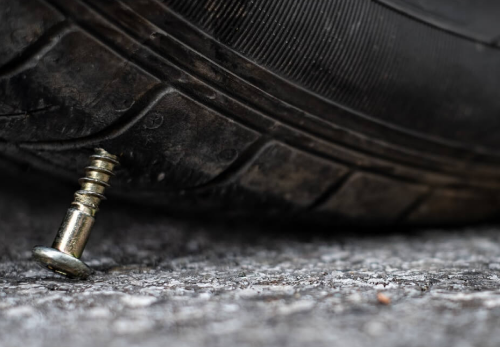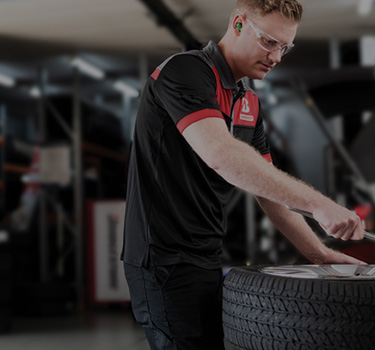Tyre Puncture Repair Services
A punctured tyre can happen when you least expect it, but with Bridgestone Select Tyre & Auto and Bridgestone Service Centres across Australia, help is always nearby. We provide expert puncture repair services that comply with the Australian Safety Standard AS 1973-1993, ensuring your safety and peace of mind.
If you're unsure whether your tyre can be repaired or needs replacing, our experienced tyre specialists can assess the damage and provide expert advice. Contact your nearest Bridgestone store today.
What to do if you get a punctured tyre?
If you experience a punctured tyre, bring your vehicle to your nearest Bridgestone Select Tyre & Auto or Bridgestone Service Centre immediately. Our tyre technicians will assess the damage and determine if it can be safely repaired.
Our puncture repair process:
- Remove the tyre from the wheel
- Inspect the puncture and overall tyre condition
- Assess the integrity of the tyre
- Determine if a repair is safe and legal
If your tyre can be repaired, our technician will fix the puncture, balance the wheel, and securely refit it to your car for a smooth ride.
When can a tyre be repaired?
For safety reasons, tyre punctures can only be repaired if they meet the following conditions:
- Puncture Location: The puncture must be within the central tread area (see green area on the repair guide chart).
- Puncture Angle: The puncture must be less than 45° from vertical.
- Puncture Size: Maximum of 6mm for standard tyres and 10mm for truck and bus radial tyres.
- Tread Depth: The tyre must have at least 1.6mm of remaining tread.
- No Run-Flat Damage: The tyre should not show signs of underinflation or damage from being driven flat.
- Previous Repairs: Maximum of 3 previous repairs (or 2 repairs for Run Flat Tyres, with specific spacing requirements).
During repair, both the puncture hole and the tyre's inner liner must be sealed to prevent air leaks and water damage, preserving the tyre's structural integrity.

*When repairing a puncture both the hole (otherwise referred to as the injury channel) and the inner liner of the tyre must be sealed. This prevents air from escaping or water entering the injury channel and compromising the structural integrity of the tyre.

Common types of tyre puncture
Tyre punctures can happen in several ways, and knowing the cause can help determine whether a repair is possible or if a replacement is needed. Your nearest Bridgestone tyre technician will assess the damage based on these factors. Here are the most common types of punctures:
- Penetrative Punctures: Sharp objects like nails or screws puncture the tread.
- Sidewall Cuts & Slashes: Caused by roadside debris like glass or metal.
- Sudden Air Loss (Sidewall Punctures): Can lead to complete deflation.
- Slow Leaks: Due to valve stem damage or inner tyre cracks.
- Impact Punctures: Result from hitting curbs or potholes.
- Pinch Flats: Occur when the tyre is pinched between the rim and a hard object.
If you're unsure about your puncture, contact your nearest Bridgestone centre for expert advice.
Punctured tyres
Tips to avoid tyre punctures
Reduce the risk of a punctured tyre with these simple maintenance tips:
- Inspect Tyres Regularly: Check for embedded nails, glass, or sharp objects.
- Maintain Proper Inflation: Keep tyres at the recommended pressure, including the spare.
- Avoid Road Hazards: Steer clear of debris, potholes, and rough road edges.
- Check Your Spare Tyre: Ensure your spare is in good condition in case of emergencies.
We advise against driving on a flat or partially deflated tyre, as it may cause further damage and make repairs more difficult. If you suspect a flat tyre, it's best to pull over safely, replace it with your spare, and visit a Bridgestone store for assistance.
When can’t a tyre be repaired?
Signs you need a replacement, not a repair
Not all punctures can be repaired. Your tyre must be replaced if any of the following conditions apply:
- Sidewall or Shoulder Damage: Due to continuous flexing, sidewalls cannot be safely repaired.
- Large Punctures: Any puncture larger than 6mm (10mm for trucks and buses) requires replacement.
- Exposed Cords or Bulging: If internal layers of the tyre are exposed, it is unsafe to repair.
- Multiple Punctures: Multiple punctures compromise tyre integrity.
- Excessive Wear or Damage: If the tread is below legal limits or the tyre is too old, replacement is necessary.
At Bridgestone, our technicians follow strict manufacturer guidelines and Australian safety standards to determine whether a repair is possible or if a replacement is necessary.
Frequently asked questions
-
How much does a car tyre puncture repair cost?
The cost of a tyre puncture repair can vary depending on factors such as the type, size, and extent of the damage to your tyre. At Bridgestone Select Tyre & Auto and Bridgestone Service Centres, our experienced technicians are equipped to assess and repair punctures safely and efficiently. To get an accurate estimate for your specific tyre, we recommend reaching out to your nearest Bridgestone store.
Contact us today for expert advice and a repair quote tailored to your needs.
-
Is it safe to drive with a string plug in my tyre?
Temporary string repairs (also known as rope plugs or string plugs) should never be used as a permanent solution. These repairs only seal the outer surface, leaving the inner liner exposed to damage and increasing the risk of tyre failure. Always visit a Bridgestone professional for a safe and compliant repair.
The following stores offer tyre puncture and repair
-
List View
Sorry, we can’t seem to find any store in that area.
Try broadening your location radius above or give us a call on 131 229 if you need urgent assistance.
